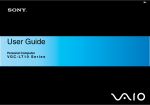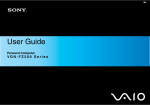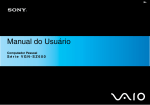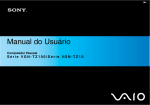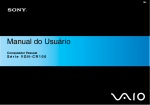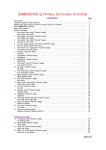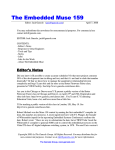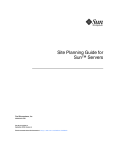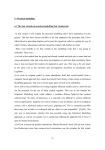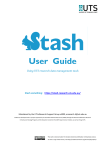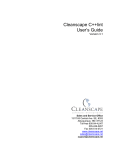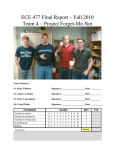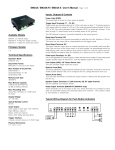Download Institute of Technology, Carlow
Transcript
Institute of Technology, Carlow
B.Sc (Honour) in Software Engineering
Research Report
For
MISRA C Code Compliance Checker Project
Student Name:
Mingjun Zhou
Student ID:
C00094981
Supervisor:
Dr. Christophe Meudec
Date:
01/12/2009
Research Report
1
Table of Content
1
2
3
4
Introduction...............................................................................................................................4
Background ...............................................................................................................................4
2.1
C Standardization .......................................................................................................4
2.2
C Language insecurities [4] ......................................................................................4
2.2.1
The programmer makes mistakes......................................................................5
2.2.2
The programmer misunderstands the language.................................................5
2.2.3
The compiler doesn’t do what the programmer expects....................................5
2.2.4
The compiler contains errors.............................................................................6
2.2.5
Run-time errors .................................................................................................6
2.3
What is MISRA? .........................................................................................................6
2.4
What is MISRA C?......................................................................................................7
2.5
Alternatives Languages and Tools ...........................................................................7
2.6
Categories of MISRA C Rules: .................................................................................8
2.7
Example of Rules: [10]...............................................................................................8
2.8
Version of MISRA-C for using...................................................................................9
Similar tools: ...........................................................................................................................10
3.1
MISRA C Rule Checker SQMlint............................................................................10
3.1.1
Overview.........................................................................................................10
3.1.2
Message format: ..............................................................................................10
3.1.3
Number of Rules can be inspected:.................................................................11
3.1.4
MISRA Rules Supported.................................................................................11
3.1.5
Operating Environment ...................................................................................12
3.1.6
Target Device [16]:..........................................................................................12
3.1.7
Position............................................................................................................12
3.1.8
Report output files...........................................................................................12
3.1.9
How to use ......................................................................................................13
3.2
Pc-lint .........................................................................................................................13
3.2.1
Overview[19] ..................................................................................................13
3.2.2
Example of using.............................................................................................14
3.2.3
PC-Lint MISRA-C Rule checking statistics....................................................15
3.2.4
How to integrate into IDE ...............................................................................17
3.2.5
How to use ......................................................................................................18
3.3
Conclusion for Similar tools: ...................................................................................19
Parsing in general....................................................................................................................20
4.1
Why does this project need parsing? ....................................................................20
4.2
Parsing in English sentence ...................................................................................20
4.3
Parsing technique used in Computer Science field.............................................21
4.4
Parser [22] .................................................................................................................22
4.4.1
Lexical analyser [25].......................................................................................22
4.4.2
Token [25] .......................................................................................................22
4.4.3
Types of parsers...............................................................................................23
4.5
Overview of Parsing Process .................................................................................23
Research Report
2
5
Parser generator tools:.............................................................................................................23
5.1
Lex/yacc.....................................................................................................................23
5.1.1
Background .....................................................................................................23
5.1.2
How Lex & yacc works...................................................................................24
5.2
ANTLR .......................................................................................................................24
5.2.1
Background .....................................................................................................25
5.2.2
How ANTLR works ........................................................................................25
5.3
Parser generator choice for project .......................................................................25
5.4
A C grammar for ANTLR .........................................................................................26
6 Conclusion ..............................................................................................................................27
Reference ........................................................................................................................................28
Research Report
3
1 Introduction
The C programming language is used for real-time embedded application field for many reasons.
For example, language flexibility, easy associate with hardware, low memory requirements, and so
on. However, that’s only the one side of C language. On the other side, while the fully experienced
programmers enjoying the convenient which C language provided for them, there are also a lot of
problems left for those inexperienced programmers who would misunderstand the language, or
make mistake when they are doing the program. Typically, for those real-time embedded
applications which used in motor industry have considerably more safety-related requirement. If
some problems could ever happen, that will cost life. So in this critic situation, there indeed need
some standard to guide all the programmers to follow. That’s why “MISRA C” [1] was introduced
to this issue.
This project is to build up a tool for checking whether the c code following the guideline which
provided by MISRA C. It will help the programmer to check their code and also guide them to
build up the good coding style.
2 Background
2.1 C Standardization
A standard specification of C was established by the American National Standards Institute (ANSI)
committee in 1983. In 1989, after a long time and dramatic hard working, this standard was
completed and approved as ANSI X3.159-1989 “Programming Language C.” [2] This standard is
often referred as “ANSI C” or “C89”.
“In 1990, the ANSI C standard (with a few minor modifications) was adopted by the
International Organization for Standardization as ISO/IEC 9899:1990. This version is
sometimes called C90. Therefore, the terms "C89" and "C90" refer to essentially the same
language.”[3]
The contents in those two standardizations are identical, but the only slight difference between
them is the section numbering.
The MISRA C standard follows the section numbering of the ISO standard.
2.2 C Language insecurities [4]
Research Report
4
C programming language is well known as the kind of language that is easy to get into,
but hard to control well. Similar with any programming language, there are numerous
of problems can happen while using C language. Those problems are categorised
below:
2.2.1 The programmer makes mistakes
The mistakes are made by programmers can be as simple as mistyping a variable
name, or as complicated as misunderstanding an algorithm.
First, The C language is a very flexible programming language, it gives the widely
flexibility and controllability to programmer, thus, program can be either written as
well structured and clean, easy-to-understanding code, or written as perverse and
extremely hard-to-understanding code. Obviously, the first style code is what people
expect to see in a safety-related system.
Second, the syntax of C is easy to make a mistyped mistake be a valid code. For
instance, the type in assignment (‘=’) instead of logical comparison (‘= =’), the result
is almost always valid but clearly, it’s wrong.
Third, theoretically, the principle of C is to assume that programmers would know
what they are doing. In other words, if a programmer makes a compatible mistake,
and he might not get any warning at all. For example, intends to store a floating-point
data type number in an integer for using to represent a Boolean value.
2.2.2 The programmer misunderstands the language
For those inexperienced programmers, there are largely a number of areas in C
language that are easily misunderstood. Operator precedence, for instance, is well
defined rule in C language, but these rules are still very complicated to fully
understand even to an experienced programmer, therefore, there is also a big chance
to make wrong assumptions about operator precedence in a particular expression.
2.2.3 The compiler doesn’t do what the programmer
expects
“There are many areas of the C language which are not completely defined, and
so behaviour may vary from one compiler to another. In some cases the behaviour
can vary even within a single compiler, depending on the context. Altogether the
C standard, in Annex G, lists 201 issues that may vary in this way. This can
present a sizeable problem with the language, particularly when it comes to
Research Report
5
portability between compilers. However, in its favour, the C standard does at least
list the issues, so they are known.”[4]
2.2.4 The compiler contains errors
“Because there are aspects of the C language that are hard to understand,
compiler writers have been known to misinterpret the standard and implement it
incorrectly. Some areas of the language are more prone to this than others. In
addition, compiler writers sometimes consciously choose to vary from the
standard.”[4]
2.2.5 Run-time errors
“C is generally poor in providing run-time checking. This is one of the reasons
why the code generated by C tends to be small and efficient, but there is a price to
pay in terms of detecting errors during execution. C compilers generally do not
provide run-time checking for such common problems as arithmetic exceptions
(e.g. divide by zero), overflow, validity of addresses for pointers, or array bound
errors.”[4]
2.3 What is MISRA?
Fig.1 MISRA Logo [5]
“MISRA, The Motor Industry Software Reliability Association, is collaboration between vehicle
manufacturers, component suppliers and engineering consultancies which seeks to promote best
practice in developing safety-related electronic systems in road vehicles and other embedded
systems.”[6]
The MISRA project started in 1990; the mission of this project was “To provide assistance to the
automotive industry in the application and creation within vehicle systems of safe and reliable
software.” [6]
“The original project was part of the UK Government’s “SafeIT” programme, but now is
self-supported.” [7]
Research Report
6
There are few examples of MISRA Publications:
z November 1994: Development guidelines for vehicle based software (The MISRA
Guidelines)
z April 1998: Guidelines for the use of the C language in vehicle based software (MISRA C)
z October 2004: MISRA-C:2004 –Guidelines for the use of the C language in critical
systems(MISRA C2)
2.4 What is MISRA C?
From the section of 2.2, very easily, we notice that a great care should be taken whenever using C
as a programming language within safety-related systems. Surely, because of the issues mentioned
above, many of concerns have to be involved. Full C language is not suitable for programming
safety-related systems.
However, at the same time, C language is sophisticated language. After years and years, it has
been well analyzed and fully practiced. Thus, its shortage has been defined and understood well.
Furthermore, there are numerous tools available for checking C source code and warning the
programmer of the occurrence of problem. There are many constraints rules in those tools for
checking whether the c code is suitable for safety-related system. Those constraints rules or called
guidelines are often referred as a ‘subset of C language’.
MISRA C is one of those guidelines to aid the development of safety related systems in ‘C’ in the
automotive world was produced by MISRA.
“As part of these activities, MISRA C was first published in 1998. The intention was to
provide a "restricted subset of a standardized structured language" as required in the 1994
MISRA Guidelines for automotive systems being developed to meet the requirements of Safety
Integrity Level (SIL) 2 and above.”[8]
So far there are two versions of MISRA C were well published, there are:
MISRA C 1998:
‘advisory’ rules.
there are 127 Rules in total in which included 93 ‘required’ rules and 34
MISRA C 2004: it’s a upgrade version of 1998’s, there are 141 Rules in total in which
included 121 ‘required’ rules, 20 ‘advisory’ rules, and there are also 15 old rules were deleted.
2.5 Alternatives Languages and Tools
Beside MISRA C, there are other languages generally recognised to be more suitable than C. Ada
is an example of others.
Ada is designed for highly reliable, real-time and embedded system.
Research Report
7
The features of Ada are: [9]
z Run-time error checking
z Program library mechanism
z Object-oriented Programming
z Strong typing
z Generics
z Standard interrupt handling mechanism
z Language Level Tasking/Synchronisation
z Fixed Point Types
2.6 Categories of MISRA C Rules:
There are 17 categories in MISRA C, as following:
z
z
z
z
z
z
z
z
z
z
z
z
z
z
z
z
z
Environment
Character Sets
Comments
Identifiers
Types
Constants
Declarations and Definitions
Initialisation
Operators
Conversions
Expressions
Control Flow
Functions
Pre-processing Directives
Pointers and arrays
Structures and Unions
Standard Libraries`
2.7 Example of Rules: [10]
Rule 33 (required):
The right hand operand of a && or || operator shall not
contain side effects.
There are some situations in C code where certain parts of expressions may not be
evaluated. If these sub-expressions contain side effects then those side effects may or
may not occur, depending on the values of other sub expressions. The operators which
can lead to this problem are &&, || and ?:. In the case of the first two (logical
operators) the evaluation of the right-hand operand is conditional on the value of the
lefthand operand. In the case of the ?: operator, either the second or third operands
are evaluated but not both. The conditional evaluation of the right hand operand of
Research Report
8
one of the logical operators can easily cause problems if the programmer relies on a
side effect occurring. The ?: operator is specifically provided to choose between two
sub-expressions, and is therefore less likely to lead to mistakes.
For example:
if ( ishigh && ( x == i++ ) )
/* Incorrect */
if ( ishigh && ( x == f(x) ) ) /* Only acceptable if f(x) is known to
have no side effects */
Rule 49 (advisory):
Tests of a value against zero should be made explicit,
unless theoperand is effectively Boolean
Where a data value is to be tested against zero then the test should be made explicit.
The exception to this rule is data which is representing a Boolean value, even though
in C this will, in practice, be an integer. This rule is in the interests of clarity, and
makes clear the distinction between integers and logical values.
For example, if x is an integer, then:
if ( x != 0 ) /* Correct way of testing x is non-zero */
if ( x )
/* Incorrect, unless x is effectively Boolean data
(e.g. a flag) */
Rule 50 (required):
Floating point variables shall not be tested for exact
equality or inequality.
The inherent nature of floating point types is such that comparisons of equality will
often not evaluate to true even when they are expected to. In addition the behaviour of
such a comparison cannot be predicted before execution, and may well vary from one
implementation to another. For example the result of the test in the following code is
unpredictable:
F_32 x, y;
/* some calculations in here */
if ( x == y )
{ /* ... */ }
2.8 Version of MISRA-C for using
Decision on version use for my project will be MISRA-C 1998, and the reasons are
pretty simple and clear:
This is academic project so that there is a limitation for studying resources, the
MISRA-C 1998 is the only book I can find and downloaded from internet for free.
Even thought I have found all the rules for version 2004, for me, there is not much
different working on and learning knowledge from doing the old one.
Research Report
9
3 Similar tools:
3.1 MISRA C Rule Checker SQMlint
3.1.1 Overview
SQMlint is a software produced by Renesas Technology company. It is a tool to statically check if
the C source code compliant MISRA C rules. Example: [11]
typedef unsigned short UINT16;
extern volatile UINT16 port1 = 0;
extern volatile UINT16 port2 = 0;
void func(void);
void func(void)
{
while(port1 != 0) {
if (port2 == 0) {
break;
}
}
}
As example shows above, when a program is inspected by SQMlint, a report message will show
down below:
[MISRA(58) Complaining : test.c, 10] 'break' statement shall not be used (except in a 'switch')
3.1.2 Message format:
There are two levels MISRA C Rule:
1. Complaining
When any part of the source code deviates from MISRA C rules
2. Warning
When any part of the source code is likely to deviate from MISRA C rules
Therefore, the message format for those two levels would look like as follow:
Fig. 2: Format of Report Message [12]
Research Report
10
3.1.3 Number of Rules can be inspected:
Fig. 3: Rules can be inspected [13]
3.1.4 MISRA Rules Supported
Fig. 4: MISRA C rules supported by SQMlint V.1.03 [14]
Research Report
11
3.1.5 Operating Environment
“IBM PC/AT compatibles (Windows Vista®, Windows® XP, Windows® 2000)
SQMlint cannot be used alone; it adds MISRA C rule inspection functions to the Renesas C
compiler installed in the computer.”[15]
3.1.6 Target Device [16]:
z
z
z
z
z
z
z
SuperH RISC engine Family (32-bit RISC)
M32R Family (32-bit RISC)
M16C Family (32/16-bit, 16-bit)
R8C Family (16-bit)
H8SX Family (32-bit)
H8S Family (16-bit)
H8 Family (16-bit, 8-bit)
3.1.7 Position
The SQMlint checks source code before the code processed by compiler.
So the code generated by the compiler is unaffected by MISRA C rule
checking.
3.1.8 Report output files
Fig. 5 Position of SQMlint[17]
The result of MISRA C rule checking can be output and save into a CSV (Comma Separated Value)
format file. And this type of file can be available in most spreadsheet applications.
In the report file, each header for each column is output to the first line. The inspection results will
follow line by line. Example of an output report file as below:
Fig. 6 format of output file [12]
Research Report
12
3.1.9 How to use
For different compiler package, the command for SQMlint use will be slightly
different. For example, if using C Compiler Package for M16C family, the command
line will be like this:
Example:
“ nc30 test.c -c –misra_all –misra_report report.csv
nc308 test.c -c –misra_all –misra_report report.csv
The explanation for these commands is :
SQMlint inspects the test.c for all of the supported MISRA C rules and outputs the
result to report.csv. The test.c also is processed by the compiler.” [18]
3.2 Pc-lint
3.2.1 Overview[19]
PC-lint is a static code analysis software tool for C/C++ programming language. It has produced
and developed by Gimpel Software since 1985. PC-lint can thoroughly check C/C++ source code
for bugs, glitches, in consistencies, non-portable constructs and other sources of problems by
using K&R and ANSI standards for C. So the program developer can find and fix the bugs
efficiently.
Before continuing introducing this tool, there is little concept, to avoid confusing, has to be
mentioned first, there is another name for PC-lint as well which is called FlexeLint.
PC-Lint/FlexeLint is the same software package. But the Gimpel Software distributes it in one of
two ways.
“For the PC market (Windows, MS-DOS, OS/2) the product is distributed in binary
executable format. For all other platforms, it is distributed in shrouded C source code
format and is known as FlexeLint.”[19]
Version 9.00 is the newest release of PC- lint. Furthermore, PC-lint can be integrated into IDEs as
an external tool, and the warning message can be output to a format which IDE can recognize and
process, for example, the notepad format will be shown in my description.
In this research report, only PC-lint version 8.00 will be chosen and described. Because it’s a
commercial product and this version is the one found online for free. The steps for how to
integrate it into Borland C++ builder 6.0(BCB) and how to use it will be described later.
Research Report
13
3.2.2 Example of using
The example program used here is called BADCODE.C from website.
Fig. 7: example source code from web [20]
The red colour highlight shows the coding mistakes. First the output with 12 errors from C51
complier will be shown:
Fig. 8 the error report detected by C51 compiler [20]
Then, the output with 26 errors from PC-Lint will be shown as follow:
Research Report
14
Fig. 9 the errors and warning message detected by PC –Lint [20]
As shown, the PC-Lint can detect more errors than normal C compiler.
3.2.3 PC-Lint MISRA-C Rule checking statistics
Fig. 10 PC-Lint MISRA-C Rule checking statistics [19]
The table above shows that, up to December 2001, PC-lint can detect 74% overall and
82% of the “Required” rules. There are 12 rules are not detected by PC-Lint or likely
the compiler that will have to be checked by manually in code review. The following
are the compliance Matrix for using PC-Lint.
Research Report
15
Fig. 11 Rule 1-25[19]
Fig. 13 Rule 51-75
Fig. 12 Rule 26-50[19]
[19]
Fig. 14 Rule 76-100[19]
Note:
“Yes++ can be checked but requires
specific setting up with Pc-Lint
Yes+ == no Specific MISRA-Rule Message
***** == REQUIRED RULE Not checked by
PC-Lint Required manual checking” [19]
Research Report
Fig. 15 Rule 101-127[19]
16
3.2.4 How to integrate into IDE
There are many IDEs that PC-lint can be integrated, for example, Visual Studio 2005/2008,
Visual C, etc. I only tried it in Borland C++6.0 successfully, procedures show as follow:
1.
2.
Download PC-lint 8.0 and unzip it to local directory, for example, C:\Lint. This can be
change, but the BCBLint .bat file need to be modified correspondingly.
Open BCB 6.0 and choose ToolsÆConfigure Tools and choose Add in the popup window.
Fig. 16 Configure Tools
3.
Enter follow information:
Fig. 17 Enter Information
Title: &Lint
Program: C:\Lint\BCBLint.bat
Working Dir: E:\Lint
Parameters: $EDNAME
4.
5.
Click OK, and Close this window.
The Lint Tool will appear in the Tools options
Fig .18 Added tool appear in the Tools option
Research Report
17
6.
7.
The std.lnt file in C:\Lint\lnt directory need to be modified to as follow:
// Borland C++ Builder, -si4 -sp4, lib-owl5.lnt lib-w32.lnt
// Standard lint options
au-misra.lnt //standard Misra C lint option
co-cb.lnt
lib-ow15.lnt lib-w32.lnt
options.lnt -d_FLAT_ -u_SMALL_ -si4 -sp4
// depends on the local file directory
-i C:\Program Files\Borland\CBuilder6\Include;
-i C:\Program Files\Borland\CBuilder6\Include\Vcl;
-i C:\Program Files\Borland\CBuilder6\Imports;
-i C:\Program Files\Borland\CBuilder6\Projects;
//end
The contents in BCBLint.bat file is:
Lint-nt -i"c:\Lint\lnt" std.lnt -os(D:\errorlog.txt) -w2 -u %1
//error messages output to a new created notepad file.
C:\windows\notepad.exe "d:\errorlog.txt"
3.2.5 How to use
After above procedure, the “how to use” is turned to pretty straightforward and simple.
Open a testing project or a C/C++ file.
1.
Choose Lint from Tools menu.
Fig. 19 Location of new added Lint tool
Research Report
18
2.
The Lint will be executed and message file will be created and display on the screen. The
error message from the example program Fig. 7 as follow:
Fig. 20 error message from tested BADCODE.C code
Depending on the option we use here, the output information would look different compare with
the original example. The MISRA C rule has been included and highlighted in my test
The modification can be done by changing the “options.lnt”, in order to ignore some error detect.
The “-w2” options as show in the “BCBLint.bat” means only display error and warning message.
Note, there is a “PC-Lint.pdf” file in the folder that shows all information in fully details.
3.3 Conclusion for Similar tools:
Since the limitation of time, I couldn’t study those tools very well. Base on what I
have done, I got conclusion for those tools.
z I couldn’t try SQMlint since it’s a commercial product and there is no free release.
But I found PC- lint and tried it.
z From the MISRA C supported point of view, 94 compare with 86 in totals,
PC-lint support more Rules than SQMlint.
z For the message format, since MISRA C rule checker SQMLint is a specific tool
made for MISRA C, so its message is more clear, detailed and easy to read.
PC-Lint, however, it provides more other error checking besides MISRA C, so its
format is very simple and unclear.
z It seems like once PC-lint is integrated into IDEs, it would be very easy to
implement. But, the configuration is a little trick and difficult, user has to spend
more time to study. Furthermore, PC-lint can be executed in command line. This
Research Report
19
z
is similar with SQMlint.
The SQMlint has to be used with those compliers which already mentioned
earlier, but PC-lint doesn’t care about the type of compliers. It checks source code
statically.
From those two tools I have learned something useful for my own project:
My tool will concentrate on MISRA C-1998 rules. It will provide easy approach to
execute the C source code in command line format, and provide friendly and readable
feedback message. Ideally, like PC-lint, it can be integrated into other IDEs.
4 Parsing in general
4.1 Why does this project need parsing?
The reason why the parsing technology will be involved in this project is that the
input C source code needs to be analyses and checked whether it compliance the
MISRA C 1998 Guidelines or not. For achieving this goal the existing C grammar
must be properly parsed and the new rules for MISRA C rules grammar for my target
tool need to be made in order to parsing the input source code. Then, depending on
the result of parsing, the software can compare each line of the source code and see if
there is any code against the MISRA C guideline. The software should know what it
going to check, and what exactly the rules it is going to follow. What is right coding
and what is wrong. Finally, it should give correct feedback to the people whoever
using this tool.
4.2 Parsing in English sentence
Parsing is, in general speaking, a process that analysis the structure of the statements
in a human or artificial language depending on the set of grammars which defines
possible structures. The diagram blow shows the structure of the sentence “The dog
chased the black cat.”
Research Report
20
Fig. 7 Parsing: Structure of a sentence [21]
4.3 Parsing technique used in Computer
Science field
“In computer science and linguistics, parsing, or more formally, syntactic or
grammatical analysis, is the process of analysing a text, made of the sequence of
tokens (for example, words), to determine its grammatical structure based on a given
formal grammar.” [22]
Parsing can be done either top-down or bottom up.
• Top-down parsing
“Top-down parsing is a strategy of analysing unknown data relationships by
hypothesising general parse tree structures and then considering whether the
known fundamental structures are compatible with the hypothesis. It occurs in
the analysis of both natural languages and computer languages.
Top-down parsing can be viewed as an attempt to find left-most derivations of
an input-stream by searching for parse-trees using a top-down expansion of
the given formal grammar rules. Tokens are consumed from left to right.
Inclusive choice is used to accommodate ambiguity by expanding all
alternative right-hand-sides of grammar rules.” [23]
•
Bottom-up parsing
Research Report
21
“Bottom-up parsing (also known as shift-reduce parsing) is a strategy for
analyzing unknown data relationships that attempts to identify the most
fundamental units first, and then to infer higher-order structures from them.
It attempts to build trees upward toward the start symbol. It occurs in the
analysis of both natural languages and computer languages.”[24]
4.4 Parser [22]
In computer science, a parser is a component of either an interpreter or a compiler,
that process a set of texts as input and identifies the structure of these texts depending
on a given grammar so that can extract information.
The parser generally creates tokens from the sequence of input text by using a
separate lexical analyser.
“Parsers may be programmed by hand or may be (semi-)automatically generated (in
some programming languages) by a tool (such as Yacc) from a grammar written in
Backus-Naur form.”[22]
4.4.1 Lexical analyser [25]
Lexical analyser, or called lexers, is a program that performs lexical analysis which is
the process of converting a sequence of characters into a sequence of tokens.
4.4.2 Token [25]
A token, also as a lexeme, is a sequence of characters that can be considered as a unit
according to function which gives them meaning; it is either a word or an operator.
For example, the following C programming language expression:
Sum =4+5;
It can be tokenised into a following table:
Lexeme
Sum
=
4
+
5
;
Research Report
Token type
Identifier
Assignment operator
Number
Addition operator
Number
End of statement
22
The Tokens in a Language are frequently defined by regular expressions which are
understood by a lexical analyser generator such as lex. A regular expression specifies
a set of strings to be matched. It contains text characters and operator characters.
4.4.3 Types of parsers
Same as types of parsing techniques, there also are two types of parsers:
•
•
Top-down parsers (LL Parser)
Bottom-up parsers(LR Parser)
4.5 Overview of Parsing Process
For computer language parsing, there are commonly two levels of
grammar: lexical and syntactic.
The first stage is doing lexical analysis, which is also called the token
generation, by splitting the input character stream into meaningful
symbols defined by a grammar of regular expressions.
The second stage is parsing or syntactic analysis which is checking
whether the tokens form an allowable expression or not. And create a
tree for those tokens.
The final stage, the token tree will go to a Parse tree which will
optionally output text. [22]
Fig.8. String Process [22]
5 Parser generator tools:
5.1 Lex/yacc
5.1.1 Background
“Lex and yacc were both developed at Bell Laboratories in the 1970s. Yacc
was the first of the two, developed by Stephen C. Johnson. Lex was designed
by Muike Lesk and Eric Schmidt to work with yacc.” [26]
Lex refers to Lexical Analysis.
Research Report
23
Yacc refers to Yet another Compiler Compiler.
5.1.2 How Lex & yacc works
Fig. 9 Compilation Sequence [27]
From the diagram above, we can see the sequence of process. [27]
At the first layer, or stage, lex can generate C code for a lexical analyser based on the
patterns we put in it. And lexical analyser will process and convert the input string to
tokens. Those tokens are numerical representations of input strings, and simplify
processing. The lexical analyser enters those identifiers in a symbol table when it
finds them from the input stream. Besides identifiers, the symbol table could also
contain other information such as data type (integer or real) and location of the
variable in memory. All subsequent references to identifiers refer to the appropriate
symbol table index.
The second layer, or stage, yacc will generate C code for a syntax analyser or parser
based on the grammar we put in it. Syntax analyser will analyse tokens from the
lexical analyser according on the grammar rules, and create a syntax tree. The syntax
tree imposes a hierarchical structure the tokens. In this diagram, the operator
precedence and associativity are apparent in the syntax tree.
5.2 ANTLR
Research Report
24
5.2.1 Background
ANTLR refers to ANother Tool for Language Recognition. [28]
It is the second generation parser generator. The first generation was called Purdue
Compiler Construction Tool Set (PCCTS) which first developed in 1989. Both of
them were designed and implemented by Professor Terence Parr of the University of
San Francisco. [28]
“ANTLR uses Extended Backus-Naur (EBNF) grammars which can directly express
optional and repeated elements.ANTLR supports LL(*) parsing which can allow
program infinitely lookahead for selecting the rule alternative that matches the
portion of the input stream being evaluated.
An LL(k) parser is a top-down parser that parses from left to right, constructs a
leftmost derivation of the input and looks ahead k tokens when selecting between rule
alternatives. The * means any number of lookahead tokens.” [28]
ANTLR also has Lexical analyser and syntax analyser parts, called Lexer and Parser
respectively.
5.2.2 How ANTLR works
Fig. 10 ANTLR Working approach [29]
Character stream is input into Lexer, Lexer then converts the stream of characters to a
stream of tokens based on the lexer grammar. The tokens, after, go into Parser. Parser
then constructs those tokens to an AST (Abstract Syntax Tree). The AST will be
delivered to Tree Parser where it gets process. And finally, text will optionally output
by using StringTemplate which is a library that supports using templates with place
holders for outputting text(ex. Java source code)
5.3 Parser generator choice for project
The parser generator tool I am going to choice for my project is ANTLR. Even though,
lex/yacc is seemed to be a better choice for C. But from my point of view, ANTLR
has those following advantages for me:
Research Report
25
z
z
z
z
z
ANTLR is used in windows system environment, yacc is designed for using in
UNIX OR Linux.
ANTLR provide friendly GUI for help programmer visualize what we are
building.
ANTLR generates recursive parsers and provide good error reporting[30]
Open source and free, ANTLR users are worldwide, it’s easier to identify and
correct bugs for this parser
My programming language target generated would be in Java.
5.4 A C grammar for ANTLR
The only C grammar resource for ANTLR has been found online is:
“ANSI C ANTLR v3 grammar Which translated from Jutta Degener’s 1995 ANSI C yacc
grammar by Terence Parr in July 2006.”[31]
There are hundreds lines of code, here can only show part of the grammar, and one of
them looks like:
“
storage_class_specifier
: 'extern'
| 'static'
| 'auto'
| 'register'
;
” [31]
This segment of code describes that there are four terminal words, as also can be
called ‘Key words’ in C, ‘extern’, ‘static’, ‘auto’, ‘register’ were defined to a identifier
called ‘storage_class_specifier’.
There is another example of the grammar:
“
Fragment
LETTER
:
'$'
|
'A'..'Z'
|
'a'..'z'
|
'_'
;
” [31]
The name “LETTER” is a Non-terminal word represents any combination of the legal
word that we can write in C programming language. In this case it could contain any
number of ‘$’ or uppercase 'A' to 'Z' or lower case 'a' to 'z' or '_' no matter what the
sequence they are.
Research Report
26
6 Conclusion
After researching, I got some basic idea about what I am going to do, and studied the relative
technical knowledge. For my project, I have to use third party tool called “ANTLR” for generating
parser tree to analysis the input C source code. The ANSI C grammar has been found, but need
more studying and understanding. Furthermore, I need more understudying about MISRA C 1998
guideline and trying to work out how to change the theory to grammar. Finally, using this
grammar and my tool to check the input C source code, and output the feedback information to
user.
Research Report
27
7 Reference
[1] “Guidelines for the use of the C Language in Vehicle-Based Software,” published
in 1998 by MISRA, www.misra.org.uk
[2] ANSI X3.159-1989, Programming languages - C, American National Standards
Institute,1989
[3] "ANSI C." Wikipedia, The Free Encyclopedia. 6 Nov 2009
http://en.wikipedia.org/wiki/ANSI_C
[4] p2-p4, The Motor Industry Software Reliability Association, Guidelines For The
Use Of The C Language In Vehicle Based Software, April 1998
[5] "MISRA" triangle logo is registered trademarks of MIRA Ltd, held on behalf of
the MISRA Consortium.
[6] Frequently asked questions about MISRA. www.misra.org.uk
[7] An Introduction to MISRA C++ University of Warwick, Chris TappKeylevel
Consultants Ltd, 28 th June 2007 28th.
[8] “Introduction to MISRA C, http://www.misra-c2.org/, MISRA
[9] p7-p8. The Contrast Between MISRA C and Ada 95, Julian Day, MISRA C Forum,
Octorber 2002
[10] p39, p46. Section 7: Rules, The Motor Industry Software Reliability Association,
Guidelines For The Use Of The C Language In Vehicle Based Software, April 1998
[11] p2, MISRA C Rule Checker SQMlint V.1.03 User’s Manual, Rev.1.00
Aug.1.2006, Renesas Technology
[12] p15, MISRA C Rule Checker SQMlint V.1.03 User’s Manual, Rev.1.00
Aug.1.2006, Renesas Technology
[13] Renesas Technology Corp, 2003-2009,
http://eu.renesas.com/fmwk.jsp?cnt=number_of_misra_c_rules_that_can_be_inspecte
d.htm&fp=/products/tools/coding_tools/extension_software_compilers/misra_c_rule_
checker_sqmlint/child_folder/&title=Number%20of%20MISRA%20C%20rules%20t
hat%20can%20be%20inspected
Research Report
28
[14] Renesas Technology Corp, 2003-2009,
http://eu.renesas.com/fmwk.jsp?cnt=misra_c_rules_supported.htm&fp=/products/tool
s/coding_tools/extension_software_compilers/misra_c_rule_checker_sqmlint/child_fo
lder/&title=MISRA%20C%20Rules%20Supported
[15] Renesas Technology Corp, 2003-2009,
http://eu.renesas.com/fmwk.jsp?cnt=operating_environment.htm&fp=/products/tools/
coding_tools/extension_software_compilers/misra_c_rule_checker_sqmlint/child_fol
der/&title=Operating%20Environment
[16] Renesas Technology Corp, 2003-2009,
http://eu.renesas.com/fmwk.jsp?cnt=misra_c_rule_checker_sqmlint_tools_product_la
nding.jsp&fp=/products/tools/coding_tools/extension_software_compilers/misra_c_ru
le_checker_sqmlint/
[17] p3, MISRA C Rule Checker SQMlint V.1.03 User’s Manual, Rev.1.00
Aug.1.2006, Renesas Technology
[18]p4, MISRA C Rule Checker SQMlint V.1.03 User’s Manual, Rev.1.00 Aug.1.2006,
Renesas Technology
[19] Reference Maunal for PC-lint/FlexeLint for C and C++, Software Version 8.00 and later
Document Version 8.00, Gimpel Software,July, 2001
[20] http://www.keil.com/pclint/example.asp
[21] Business Glossary, Barron's Educational Series, Inc.
http://www.allbusiness.com/glossaries/parsing/4949237-1.html, Copyright © 2006,
2003, 2000, 1998, 1996, 1995, 1992, 1989, 1986 by Barron's Educational Series, Inc.
Reprinted by arrangement with Publisher.
[22] http://en.wikipedia.org/wiki/Parsing
[23] http://en.wikipedia.org/wiki/Top-down_parsing
[24] http://en.wikipedia.org/wiki/Bottom-up_parsing
[25] http://en.wikipedia.org/wiki/Lexical_analysis
[26] p4, lex & yacc, John R. Levine,Tony Mason & Doug Brown, O’REILLY, 1995
[27] p4, A COMPACT GUIDE TO LEX & YACC, Tom Niemann ,
[28] http://en.wikipedia.org/wiki/ANTLR
Research Report
29
[29] ANTLR 3, R. Mark Volkmann, Partner/Software Engineer Object Computing,
Inc. (OCI)
http://jnb.ociweb.com/jnb/jnbJun2008.html#References
[30] http://www.bearcave.com/software/antlr/antlr_expr.html
[31]ANSI C ANTLR v3 Grammar, Terence Parr, July 2006
http://www.antlr.org/grammar/1153358328744/C.g
Research Report
30






























